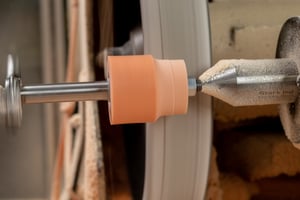Machining Polyurethane Guide
Thermoset polyurethanes are very tough and durable materials. Due to their properties, it is important that special care is taken when machining them. Polyurethanes harder than 70 Shore A can be machined using processes commonly used for machining metals. Polyurethanes softer than 80 Shore A tend to be too soft for these machining processes and are best machined by methods such as knifing, grinding, sanding, and freezing - using dry ice or liquid nitrogen.
Machining Fundamentals
Due to polyurethane’s low thermal conductivity, machining tools tend to heat up. This can significantly and rapidly raise the temperature of MPC's Durethane materials or other thermoset polyurethanes. Heat generated during the machining process causes thermal expansion of the component, making it shrink and measure under size once returned to its ambient temperature. That’s where a principle called “elastic memory” comes into play.
Elastic memory is the elastic dimensional recovery that occurs in polyurethane during and after the machining process. Machining tools must provide enough clearance to compensate for this elasticity. If not enough clearance is given, friction will increase between the cut surface and the cutting tool, aggravating heat build up. Elastic recovery after machining can result in smaller internal diameters and larger external diameters than were measured during machining.
Precision Makes Perfect
 Polyurethanes are pliable and can be distorted by too much clamping force, which can result in the final part to be distorted or misshapen. For this reason, it is important to grasp components securely without distorting them during machining. There are several other factors that contribute to a precisely machined result. Proper machine tool geometry, feed and speed rates, and use of coolants are necessary to avoid gumming up, poor finishes, and non-conforming dimensional control caused by excess heat. Cool water-soluble machining oils or other light machining lubricants are an optimal choice for polyurethanes to ensure better results.
Polyurethanes are pliable and can be distorted by too much clamping force, which can result in the final part to be distorted or misshapen. For this reason, it is important to grasp components securely without distorting them during machining. There are several other factors that contribute to a precisely machined result. Proper machine tool geometry, feed and speed rates, and use of coolants are necessary to avoid gumming up, poor finishes, and non-conforming dimensional control caused by excess heat. Cool water-soluble machining oils or other light machining lubricants are an optimal choice for polyurethanes to ensure better results.
Better Safe Than Sorry
Safety is the final trick in producing a high quality product!
Prior to machining polyurethanes, fixturing is extremely important to keep in consideration. In fact, machining should never begin until the fixture is tested for safety and security to avoid any mishaps or injuries. Improper machining can also result in excessive heat build up, causing the component to become damaged - wasting both time and materials.
Lastly, don't forget the following personal protective gear:
- Eye protection including approved safety glasses with side shields, full goggles, or full face shield
- Approved dust masks for any processes that may generate polyurethane dust or debris
For a printable version, download our informative machining polyurethane guide below:





